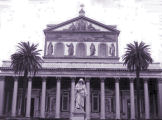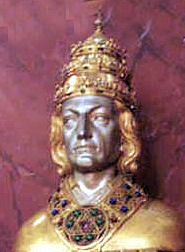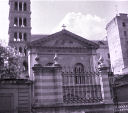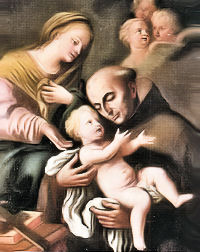Lent: March 5th
Wednesday of the Fourth Week of Lent
Other Commemorations: St. Lucius I, Pope and Martyr (RM); St. John Joseph of the Cross, Priest (RM)
» Enjoy our Liturgical Seasons series of e-books!
"Do not be amazed at this, because the hour is coming in which all who are in the tombs will hear his voice and will come out, those who have done good deeds to the resurrection of life, but those who have done wicked deeds to the resurrection of condemnation (Jn. 5:28-29)."
This day was called the 'Feria of the great scrutiny,' because in the Church of Rome, after the necessary inquiries and examinations, the list of the catechumens, who were to receive Baptism, was closed. The Station is held in the basilica of St. Paul outside the walls, both because of the size of the building, and also in order to honor the apostle of the Gentiles by offering him these new recruits, which the Church was about to make from paganism. The reader will be interested and edified by a description of this ceremony.

The Station today is at St. Paul outside-the-walls. On this day the catechumens were subjected to a new examination and, if approved, were registered for Baptism. The beginning of the four Gospels was read to them, and the Creed and the Our Father was "given," or explained to them. Today's Mass has a decided Baptismal character. The joys of this day were anticipated on Laetare Sunday.
Meditation - Submission and Christian Obedience
Continual submission to the holy will of God is the most universal of all virtues and its practice should be most familiar to you, since at every moment there arise opportunities of renouncing your own will and submitting to the will of God. His will is always easy to recognize. God has willed that all things that are extremely necessary should also be very easy to obtain. The sun, for instance, and air and water, and the other elements are most necessary for man's natural life; so, also, these things are common and freely available to everyone.
In the same way, since God has placed you in this world only to do His holy will, and your salvation depends upon this, it is, therefore, extremely necessary that you should easily know God's will in all that must be done. So, He has made it easily recognizable, manifesting His holy will in five chief ways which are very certain and evident:
- by His commandments;
- by His counsels;
- by the laws, rules and obligations of our state in life;
- by the authority of those placed over you or directing you;
- by events, since every happening is an infallible sign that God so wills, either by absolute or by permissive will.
Excerpted from The Life and Kingdom of Jesus in Christian Souls, St. John Eudes
St. Lucius I
 St. Lucius, according to the "Liber Pontificalis," was a Roman, the son of Porphyrius. When he succeeded St. Comelius, the persecution of Trebonianus Gallus was still raging, and the new Pope was exiled. Soon, however, the persecution died away and Lucius was able to return to Rome. There is extant a letter from St. Cyprian congratulating the Pope on his return from exile and praising him for his confession of Christ.
St. Lucius, according to the "Liber Pontificalis," was a Roman, the son of Porphyrius. When he succeeded St. Comelius, the persecution of Trebonianus Gallus was still raging, and the new Pope was exiled. Soon, however, the persecution died away and Lucius was able to return to Rome. There is extant a letter from St. Cyprian congratulating the Pope on his return from exile and praising him for his confession of Christ.
St. Lucius continued the policy of Cornelius in admitting repentant apostates to communion after due penance. St. Cyprian praises him for this.
The Liber Pontificalis attributes to Pope Lucius a decree ordering that two priests and three deacons should live with a bishop that they might be witnesses for him. Duchesne, however, considers this decree apocryphal.
According to the Liber Pontificalis, Pope Lucius was beheaded in the persecution of Valerian. This is almost certainly inaccurate, for Lucius died before the persecution of Valerian broke out. At any rate, St. Lucius died some time in the beginning of March 254, and was buried in the Cemetery of Calixtus. His tombstone has been discovered. The feast of St. Lucius is kept on March 4.
—Excerpted from Popes Through the Ages, by Joseph Brusher
Patronage: Copenhagen, Denmark
Highlights and Things to Do:
- Read more about Pope St. Lucius I:
- Learn more about Novatian and Novatianism at New Advent.
- St. Lucius was buried in a compartment of the papal vault in the catacombs of St. Callistus. His remains were transferred in 821 to St. Cecilia in Travestere, Rome. The sarcophagus that once held St. Lucius' remains is extant in the crypt of Santa Cecilia. It is said that some of his relics were transferred Roskilde, Denmark around 1100, and his head placed in a reliquary bust in the Saint Ansgar cathedral at Roskilde in 1910. There have been some carbon testings of the skull and the authenticity is being questioned.
St. John Joseph of the Cross
Saint John Joseph of the Cross was born on the feast of the Assumption in 1654, on the island of Ischia in the kingdom of Naples. From his childhood he was a model of virtue, and in his sixteenth year he entered the Franciscan Order of the Strict Observance, or Reform of Saint Peter of Alcantara, at Naples. Such was the edification he gave in his Order, that within three years after his profession he was sent to found a monastery in Piedmont. He assisted in its construction himself and established there the most perfect silence and monastic fervor.
One day Saint John Joseph was found in the chapel in ecstasy, raised far above the floor. He won the hearts of all his religious, and became a priest out of obedience to his Superiors. He obtained what seemed to be an inspired knowledge of moral theology, in prayer and silence. He assisted at the death of his dear mother who rejoiced and seemed to live again in his presence, and after he had sung the Mass for the repose of her soul, saw her soul ascend to heaven, to pray thereafter their God face to face.
With his superiors’ permission he established another convent and drew up rules for the Community, which the Holy See confirmed. Afterward he became a master of novices vigilant and filled with gentleness, and of a constantly even disposition. Some time later he was made Provincial of the Province of Naples, erected in the beginning of the 18th century by Clement XI. He labored hard to establish in Italy this branch of his Order, which the Sovereign Pontiff had separated from the same branch in Spain. His ministry brought him many sufferings, especially moral sufferings occasioned by numerous calumnies. Nonetheless, the Saint succeeded in his undertakings, striving to inculcate in his subjects the double spirit of contemplation and penance which Saint Peter of Alcantara had bequeathed to the Franciscans of the Strict Observance. He gave them the example of the most sublime virtues, especially of humility and religious discipline. God rewarded his zeal with numerous gifts in the supernatural order, such as those of prophecy and miracles.
Finally, consumed by labors for the glory of God, he was called to his reward. Stricken with apoplexy, he died an octogenarian in his convent at Naples, March 5, 1734. Countless posthumous miracles confirmed the sanctity and glory of the Saint, and he was canonized in 1839 by Pope Gregory XVI.
—Excerpted from Lives of the Saints for Every Day of the Year, edited by Rev. Hugo Hoever, S.O. Cist., Ph.D.
Patronage: Ischia, Italy; Naples, Italy
Symbols and Representation: Man wearing a Franciscan habit.
Highlights and Things to Do:
- Read more about St. John Joseph:

Tuesday of the Third Week of Lent
Station with San Pudenziana al Viminale (St. Pudentiana):
Today's station is in the church of St. Pudentiana, daughter of Pudens the senator. This holy virgin of Rome lived in the second century. She was remarkable for her charity, and for the zeal wherewith she sought for and buried the bodies of the martyrs. Her church is built on the very spot where stood the house in which she lived with her father and her sister St. Praxedes. St. Peter the Apostle had honored this house with his presence, during the lifetime of Pudentiana's grandfather.
For more on San Marco al Campidoglio, see:
For further information on the Station Churches, see The Stational Church.






